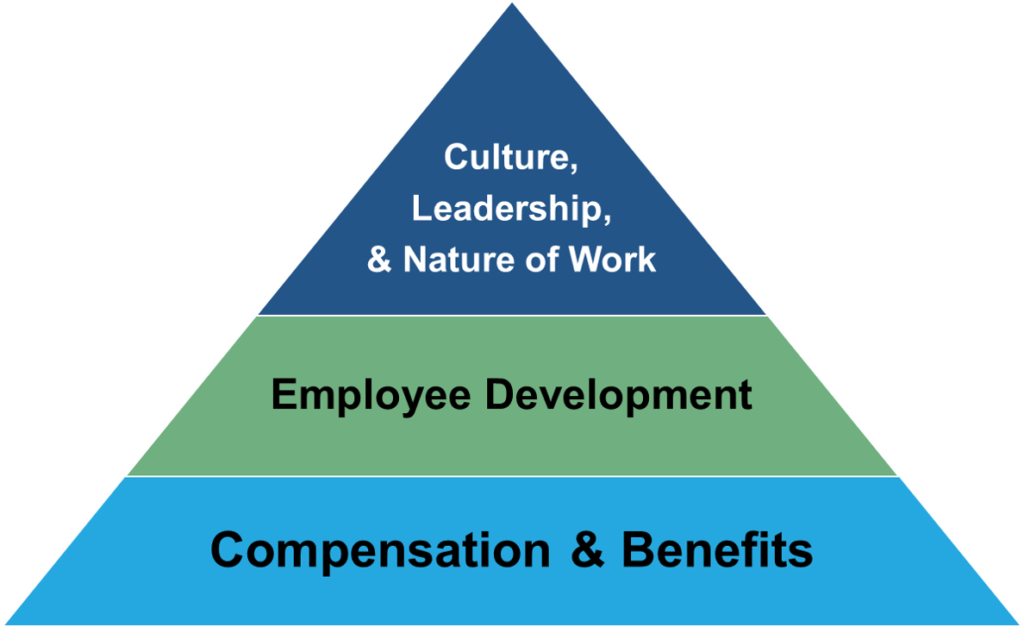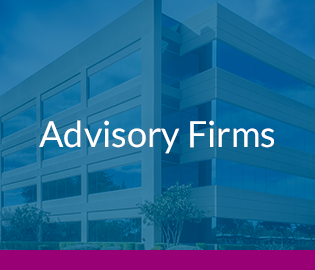As you’re reading this, we are already well into the first quarter of the New Year and a new decade. Looking out to the next 10 years what do you see for yourself, your team, and your clients? What will keep motivating and engaging your team to do their best work?
I posed this same question to myself. What project could I take on that would both motivate and engage me and inform others? I decided I wanted to draft a survey about employee engagement and motivation. I co-created a survey with Julie Littlechild from Absolute Engagement last fall to survey both managers and employees of advisory firms, to determine what really is motivating and engaging to teams. We had over 350 participants in the study with 60% being managers and 40% employees. The survey results helped to develop a framework for how to think about team engagement, and how positive team engagement can benefit your firm.
The Engagement Pyramid

Think of Maslow’s hierarchy of needs. Maslow’s hierarchy of needs is a motivational theory in psychology comprising a five-tier model of human needs, often depicted as hierarchical levels within a pyramid. We took Maslow’s concept and created an Engagement Pyramid to find out what needs must be met for team members to be engaged and why is it important.
The Engagement Pyramid is a framework for tracking engagement across your firm. We developed this pyramid based upon our survey results and there are three levels to the pyramid, and it’s formatted according to respondents’ interest. The first level covers the basic employment standards of compensation and benefits. The second level is about employee development. The top level of the pyramid addresses culture, and the cult of culture that fair compensation and benefits plus solid employee development can create.
Compensation & Benefits
Let’s be honest if people’s financial needs are not being met by your current compensation and benefits plan than it will be hard for them to be engaged at a higher level. If your employees are driving to and from work worried about how to fulfill their current and future financial obligations it will get in the way of them being happy and focused at work.
Therefore, it is important to ensure you are following a disciplined approach to setting and administering your compensation plan. Ask these questions when assessing your plan:
- Does your compensation structure encourage your team to reach the goals and vision you’ve set?
- Do you have a way to acknowledge team members who’ve gone above and beyond?
- Do you have a way to acknowledge team members who are bringing culture, vision or values to life?
Base salary is fair compensation for an employee’s roles and responsibilities. Think of it as compensation paid in exchange for carrying out the roles and responsibilities of the job description. Your plan should define a salary range for each position based on; the value of the position to the firm and the market value of the position. It’s important to revisit the salary range on an ongoing basis and adjust as needed with market changes. You should increase an employee upward within the range as their performance results warrant and as job responsibilities and skills increase.
When it comes to establishing a base salary and making decisions on salary increases, I recommend the following:
- Set compensation at 20% – 25% of the range when the employee is new in the role.
- The 50% or median represents the pay range for a more seasoned and experienced employee who is meeting or exceeding performance expectations.
- The high end of the range 75% – 80% and above is for the most experienced employee who is seen as an expert and performing at a very high level. Within this range, increased pay opportunities should only come in the form of incentive pay unless, market conditions, and competition for talent forces increasing bases above the 80% range.
- In referencing years of experience, remember this is experience relative to the employee’s current role. This should not include prior professional experience that is not directly related to the position.
Don’t underestimate the value of a complete benefits plan as well. According to our survey the top benefits that are valued most include:
- Retirement/401(k) plan – 67%
- Medical Insurance – 63%
- Flexible Work Schedule – 48%
- Paid Time Off/Vacation – 44%
- Working Remotely – 42%
- Ability to Earn Equity – 29%
- Profit Sharing – 24%
- Financial Support for Professional Development – 23%
Employee Development
The next level of the engagement pyramid is employee development.
In my experience a powerful motivator for employee development is the opportunity to learn and grow in responsibilities and contributions to the firm.. The key to developing an employee development plan is to create an annual goal setting process that produces metrics that are not only aligned with role, but also includes the development of skills and knowledge. Over time, this creates the opportunity for an employee to contribute in their current job but also develop along a continuum for career development and achievement.
As the research suggests firms seem to be doing a good job of developing goals with over three quarters saying that they are engaging in goal setting with their managers. However only half are receiving formal performance reviews and more importantly on 23% are receiving informal feedback. The importance of frequent and informal feedback cannot be overstated. Consistent, informal feedback is important to build rapport with employees and to coach them in a way that creates engagement and momentum to exceed. It also creates an opportunity to be recognized for one’s improvement and achievement. Several firms I have worked with have implemented not only weekly, monthly and quarterly feedback meetings, but also semiannual meetings with the one of the firm partners. This ensures that employees are staying connected to senior management and can have a dialogue around how their role and contributions fits with the broader firm goals. This practice also creates coaching and mentoring opportunities for partners.
Your role as the firm leader is to ensure that you are providing your employees with feedback. This means facilitating a two-way dialogue using: job descriptions, a formalized goal setting and review process, to include weekly, monthly, and quarterly check-in meetings.
One of the newest employee engagement resources is the arrival of a new breed of pulse tools, feedback apps, and anonymous social networking tools. These advanced performance evaluation methods provide regular check-ins with employees to understand where they are being challenged, and may eventually replace the dread annual performance review. Although I have not seen this practice as a trend yet in the advisory industry, I encourage mangers to be open to the use of technology to help with gathering employee feedback.
Culture, Leadership and the Work
Culture, Leadership, and the Work rose to the top of our Engagement Pyramid because employees want to feel like they belong to something.
The day you have more than one team member, you have a culture. So, the question to all of you reading this is do you reward and recognize the employees who embrace the firm culture? Culture is made up of the values, beliefs, underlying assumptions, attitudes, and behaviors shared by a group of people. The organization’s founder, partners, and other managerial staff heavily influence culture. This is because of the role they play in decision-making and creating the strategic direction for the firm. According to the respondents to the survey, the top key drivers of firm culture are: 1) having a defined culture that is experienced by all team members, 2) the purpose and vision of the firm makes employees feel that their job is important, and 3) the firm cares about its people.
Communication and leadership are critical components that comprise the highest level of the engagement pyramid. Creating an environment where employees are encouraged to speak freely and share opinions with management will build trust and loyalty. The work a person does really matters and is key to the highest levels of team engagement. The top drivers include; feeling a strong sense of purpose as a result of the work, understanding the firm’s strategic direction and goals, and how one’s role contributes to the company accomplishing goals.
Your strategies to engage your team in 2020 and beyond should focus on: financially rewarding your team members through a clear and transparent compensation plan, developing your employees through goal setting and providing more employee feedback, creating a culture of accountability, appreciation and autonomy all while emphasizing work-life balance and a compassionate leadership style.
Kelli Cruz is a Financial Planning columnist and the founder of Cruz Consulting Group in San Francisco. Email her at kelli@cruzconsultinggroup.com or follow her on Twitter at @KelliCruzSF.






